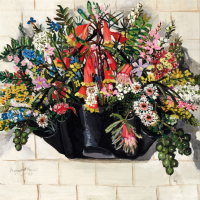14. MARGARET PRESTON

Native Flowers and Geebungs 1938 dates from a critical phase of Margaret Prestons career, when the artist consolidated her reputation as a leading exponent of Australian modernism. Since the early 1920s, Preston had regularly exhibited with Sydneys Society of Artists, whose audacious director, Sydney Ure Smith, became a vital advocate of her art. Throughout the 1920s and 30s, Prestons paintings and woodblock prints were frequently reproduced in Smiths publications Art in Australia and The Home, allowing Preston unprecedented opportunity to popularise her creative vision. Writing in The Home in June 1923, Preston boldly outlined her reasons for becoming a convert to modern art, asserting that a work of art is modern only when it represents the age it is painted in.1
The 1930s saw a change of pace for Preston, precipitated by her move from the harbourside suburb of Mosman to the more sedate bushland setting of Berowra, on Sydneys northern fringe. One visitor to the property in 1937 described a most attractive home Fourteen acres of ground au naturel, a low wide wooden house with plenty of outside inside.2 The atmosphere of Berowra would intensify Prestons admiration for Australian flora in preference to introduced species: The native flowers are passing and I am not interested in the garden ones.3 At the same time, Prestons fascination for what she understood to be the forms and principles of Aboriginal art continued to grow, shaped by her proximity to the ancient rock carvings of the Hawkesbury region.4 These two strands of native flora and Aboriginality - would prove integral to Prestons art throughout the 1930s, as she sought to promote a uniquely Australian form of modernism. The nationalistic impetus of Prestons art may be felt in one of her typically strident assertions from this period:
Let young Australia rise up and demand that works showing their national characteristics can be exhibited without jeers from press reporters and aged committee men Have courage before it is too late, before this country is poisoned by internationalism, making its art bastard forever.5
Prestons overt nationalism was in keeping with the cultural zeitgeist of Australia in the 1930s. Australias recovery from the Great Depression was accompanied by an upsurge of nationalist sentiment, coupled with growing anxiety about political unrest in Europe. In 1938, Australia marked 150 years of European colonisation, officially billed as 150 Years of Progress. At the invitation of Will Ashton, then director of the Art Gallery of New South Wales, Preston contributed six paintings to a sesquicentenary exhibition celebrating 150 years of Australian art.6
Importantly, however, Prestons vision of Australian art was averse to parochialism. Preston remained deeply engaged with developments in international modernism, and the 1930s would be punctuated by her travels abroad to the Pacific Islands in 1933, China, Korea and Japan in 1934 and the Americas in 1937.7 Moreover, Preston participated in numerous international exhibitions at this time, such as the Empire exhibitions in London and Glasgow (1937 and 1938 respectively) and the New York World Art Fair in 1939.
In Native Flowers and Geebungs, Preston celebrates the inherent unruliness of our native flora. Christmas bells are combined with tea tree, rice flowers, native bluebells, yellow peas and geebung fruits in a jumbled, massed display. Prestons robust native forms do not aspire to prettiness instead, the flowers appear of the earth; the tangible products of a harsh and ancient land.8 Remarking on the unconventional beauty of Australian flora, Preston said that Each flower is individual They never respond to being turned into bouquets, as roses and violets do.9
In the present work, the flowers natural forms are enlivened by Prestons innate feeling for colour and pattern. The composition is characteristic of the artists still-lifes of this period, with its central placement of an object in a shallow pictorial plane. The paintings flatness of perspective is accentuated by the pale tiling of the background, which remains consistent throughout the length of the composition: the floral arrangement almost seems to hover in mid-air. Preston saw her approach to light, colour and perspective as being intrinsically linked to the Australian experience:
Australia is a country that gives the impression of size and neutral colour. To give this impression on canvas I find it necessary to eliminate dancing colour and to heap my light and shadows. I have abandoned the regulation yellow-colour sunlight and made form explain light, because I feel that Australia is a country of harsh, cool light. In my effort to give a feeling of sharp flatness I force my compositions with as much solid light as possible. I am trying to suggest size, and to do this I am eliminating distracting detail.10
It is tempting to think that the former owner of this painting, Millie Phillips, saw something of herself in Preston. Both were women of formidable intellect and enterprise, with limited capacity to suffer fools. In the same year that Preston painted Native Flowers and Geebungs, Phillips would undertake the journey of a lifetime to emigrate to Australia, that country of harsh, cool light.
Footnotes:
1. Preston, M., Why I Became a Convert to Modern Art, The Home, Sydney, June 1923, vol.4, no.2, p.20
2. Edwards, D. et al, Margaret Preston, Art Gallery of New South Wales, Sydney, 2005, p.151
3. Margaret Preston, quoted in Edwards, D. et al, op. cit., p.154
4. Edwards, D. et al, op. cit., p.250
5. Margaret Preston, quoted in Edwards, D. et al, op. cit., p.16
6. Margaret Preston: Art and Life, Online Education Kit, Art Gallery of New South Wales, Sydney, 2005 (accessed October 2022): https://archive.artgallery.nsw.gov.au/__data/page/7638/MP_edkit_A.pdf
7. Ibid.
8. Edwards, D. et al, op. cit., p.154
9. Butel, E., Margaret Preston, Penguin Books, Sydney, n.p.
10. Margaret Preston, quoted in Long, G., Some Recent Paintings by Margaret Preston, Art in Australia, Sydney, May 1935, p.18
Catherine Baxendale